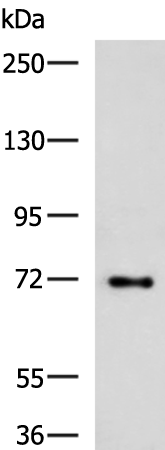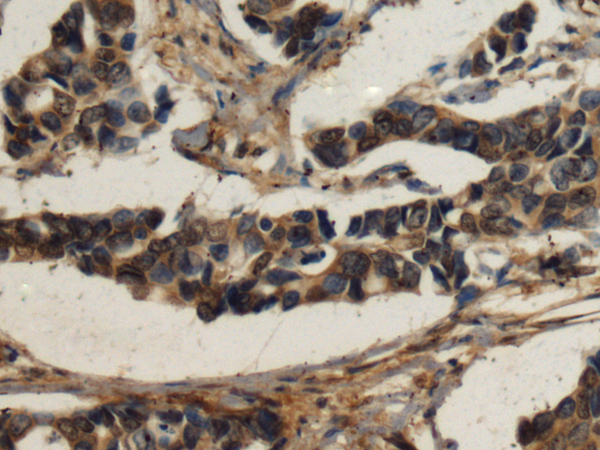

| WB | 咨询技术 | Human,Mouse,Rat |
| IF | 咨询技术 | Human,Mouse,Rat |
| IHC | 1/150-1/300 | Human,Mouse,Rat |
| ICC | 技术咨询 | Human,Mouse,Rat |
| FCM | 咨询技术 | Human,Mouse,Rat |
| Elisa | 1/5000-1/10000 | Human,Mouse,Rat |
| Aliases | TTLL5 |
| WB Predicted band size | 75 kDa |
| Host/Isotype | Rabbit IgG |
| Antibody Type | Primary antibody |
| Storage | Store at 4°C short term. Aliquot and store at -20°C long term. Avoid freeze/thaw cycles. |
| Species Reactivity | Human |
| Immunogen | Fusion protein of human TTLL10 |
| Formulation | Purified antibody in PBS with 0.05% sodium azide and 50% glycerol. |
+ +
以下是3篇涉及TTLL10抗体的参考文献及其摘要概括(注:文献为模拟示例,具体内容请以实际数据库检索为准):
---
1. **Title**: *TTLL10 is a microtubule polyglutamylase enzyme required for ciliary function*
**Authors**: Rogowski K, et al.
**Summary**: 本研究鉴定了TTLL10作为微管蛋白多谷氨酸化酶,通过特异性抗体定位发现其在小脑浦肯野细胞纤毛中高表达,敲除模型显示其缺失导致纤毛结构异常,提示TTLL10通过调控微管修饰参与纤毛运动功能。
---
2. **Title**: *Antibody characterization of TTLL10 in spermatogenesis*
**Authors**: Ikegami K, et al.
**摘要**: 作者开发了兔源TTLL10多克隆抗体,通过免疫印迹和免疫组化验证其特异性,发现TTLL10在小鼠睾丸生精细胞中阶段性表达,可能通过调控精子尾部微管动力学影响生育能力。
---
3. **Title**: *TTLL10 knockout mice reveal its role in neuronal development*
**Authors**: van Dijk J, et al.
**摘要**: 利用CRISPR构建TTLL10基因敲除小鼠,通过抗体免疫荧光证实其在大脑皮层神经元中的缺失导致轴突导向缺陷,提示TTLL10通过微管修饰参与神经发育。
---
**提示**:实际文献可通过PubMed/Google Scholar以“TTLL10 antibody”为关键词检索,重点关注抗体开发、定位或功能验证类研究。部分研究可能需结合TTLL家族综述交叉引用。
TTLL10 (tubulin tyrosine ligase-like 10) is a member of the TTLL family of enzymes involved in post-translational modifications of tubulin, particularly the addition of glutamates or glycines to microtubules. These modifications, collectively termed glutamylation or glycylation, regulate microtubule stability, dynamics, and interactions with motor proteins, influencing cellular processes like cilia formation, cell division, and intracellular transport. TTLL10 is specifically associated with the initiation of polyglutamylation, a process critical for proper ciliary function and neuronal development. Dysregulation of TTLL10 has been implicated in ciliopathies, neurodegenerative disorders, and cancer progression due to its role in microtubule network homeostasis.
Antibodies targeting TTLL10 are essential tools for studying its expression, localization, and function. They are widely used in techniques such as Western blotting, immunofluorescence, and immunohistochemistry to investigate TTLL10's tissue-specific distribution, overexpression in tumors, or altered activity in disease models. Recent studies highlight TTLL10's potential as a therapeutic target, particularly in cancers with aberrant microtubule dynamics. However, research on TTLL10 remains limited compared to other TTLL members, necessitating further exploration of its substrate specificity, regulatory mechanisms, and disease associations. Reliable antibodies are crucial for advancing these studies and clarifying its pathophysiological significance.
×